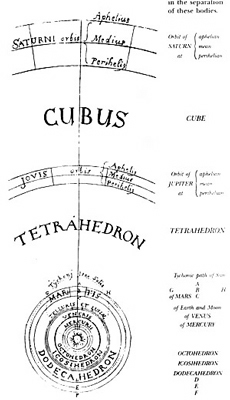
Probably the first description of the glissando in western music theory comes in Johannes Kepler's Harmonice Mundi. Kepler reconfigured the ancient doctrine of the Harmony of the Spheres in light of careful scientific observation. The traditional notion of fixed tuning relationships based on concentric circular orbits is replaced by a complex set of constantly eliding relationships oriented around the observed limits of the planetary orbits.
This follows from what has already been said, and does not require many words; for the individual planets represent, in a fashion, individual positions in the system by their motion at perihelion, insofar as it is granted to each to traverse some particular interval in the musical scale, encompassed by certain notes in it, or positions in the system. Each starts from the note or position which belonged to its motion at aphelion in the previous chapter, for Saturn indeed and the Earth G, but for Jupiter h, which can be transposed into the higher G, for Mars f, for Venus e, for Mercury A in the higher system. Here they are individually in the conventional notation. They do not indeed form the intermediate positions, which you here see filled in with notes, specifically, as they do the extremes, for they advance from one extreme to the opposite one not by leaps and intervals, but with a continually changing note, pervading all between (potentially infinite) in reality. I could not express that in any other way but by a continuous series of intermediate notes. Venus remains almost on unison, not amounting in the breadth of its tuning even to the smallest of the melodic intervals. (Kepler, 1619)
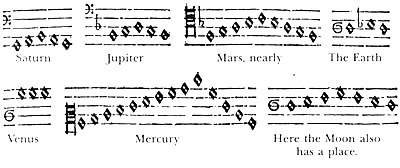
We now pass to the consideration of other phenomena accompanying the simultaneous sounding of the two simple tones, in which, as before, the motions of the air and of the other co-operating elastic bodies without and within the ear may be conceived as an undisturbed coexistence of two systems of vibrations corresponding to the two tones...(Helmholtz, 1877)
Under any circumstances, frequency, as perceived by the listener, is the result of fluctuation in air pressure as registered by the eardrum. In the case of what Alvin Lucier likes to call a "pure wave", the fluctuation in pressure corresponds to that of simple harmonic motion. Further, a single sine wave emanating from a speaker radiates in an essentially hemispheric pattern. The upshot is that the perceived amplitude of the sound in space will vary according to where you stand within the wavelength of the sinusoid relative to the speaker--there will be concentric zones of maximal, then minimal pressure. Outdoors, in the absence of any reflective surfaces, the zones of minimal pressure will be silent. A direct analogy is the concentric ripples outward from a stone dropped in a pond.
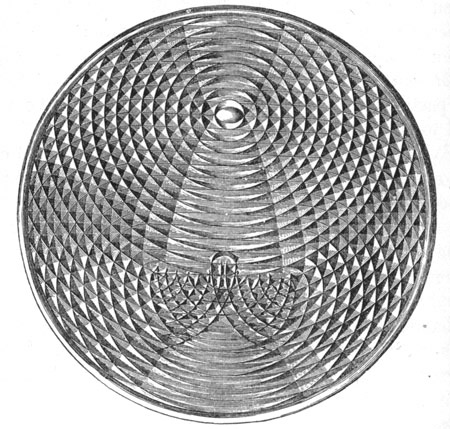
...I took a great round of wax, chopped it small with my sword-edge and worked it with all the power of my hands. Soon the wax grew warm by this dint of kneading in the glare of the lordly Sun: when it was soft I filled with it the ears of all my party. Then they tied me stiffly upright to the tabernacle, with extra ends of rope made fast to the mast above. Once more they sat and their oar-beats whitened the sea.
Speeding thus lightly we arrived within earshot of the place. The Sirens became aware of the sea-swift vessel running by them: wherefore they clearly sang to us their song:
Hither, come hither, O much-praised Odysseus: come to us, O Glory of Achaea. Bring your ship to land that you may listen to our twin voices. Never yet has any man in a dark ship passed us by without lending ear to the honey-sweet music of our lips--to go away spirit-gladdened and riper in knowledge. For we know all the toils wherewith the Gods did afflict Argives and Trojans in the broad Troad: and we know all things which shall be hereafter upon the fecund earth.
Such words they sang in lovely cadences. My heart ached to hear them out. To make the fellows loose me I frowned upon them with my brows. They bent to it ever the more stoutly while Perimedes and Eurylochus rose to tighten my former bonds and wreathed me about and about with new ones: and so it was till we were wholly past them and could no more hear the Sirens' words nor their tune... (Homer, trans. T.E. Lawrence, 1932)
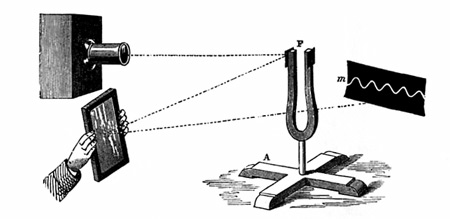
Investigation of the phenomenon of beating created by two frequencies differing only marginally from each other has a lengthy history in both music theory and psychophysics/psychoacoustics. If two tones are close enough to each other in pitch, they are perceived as a single entity. The frequency span within which this happens varies in size over the auditory spectrum but is generally referred to as the "critical band." According to one theory of pitch perception, if two frequencies fall within the critical band, both are processed by the same receptor on the basilar membrane in the ear. If the tones become closer again they begin to audibly beat. If beat frequencies are understood as difference tones, then this begins to occur when the difference in frequency reaches around 16Hz (the point where for want of a better definition pitch turns into rhythm). The beating is simply a description of the interference pattern of the two waveforms, which interact with each other in exactly the same way as the outward ripples from two stones dropped near to each other in a pond. The pattern of interference is sometimes constructive (the two tones reinforce each other) and sometimes destructive (the two tones cancel each other out). The beating pattern of two periodic signals is periodic at the rate of their difference in frequency, i.e. two sine tones at 440 Hz and 441 Hz will beat once a second--the length of time it takes for them to come back into phase with each other. Furthermore, the pitch of the perceived tone complex will shift at the same rate as the amplitude changes. The perceived frequency is the average of the two components but drifts higher and lower as the relative phase shifts.
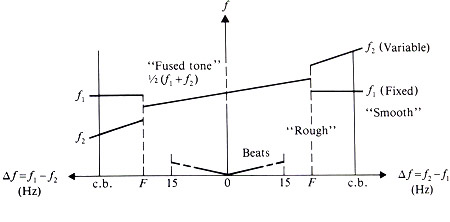
Helmholtz's siren is a mechanical tone generator in which air is forced through a perforated, spinning metal disc in a resonant tube. Something close to it, the Sirène, had been introduced in 1819 by Baron Cagniard de la Tour. Used early as a test device to measure frequency (including that of a mosquito's wings: 10,000 flutters per second), it found practical use as a warning signal on ships. The Siren is so called "in consequence of this property of being sonorous in the water", according to its patent registration, 1820. It is praised in early mechanical encyclopedias for the purity of its clear, singing tone.
The double siren is of a more advanced design: one of the discs is slightly variable in frequency.
...through every hole there is poured, as it were, a drop of air into the external atmospheric ocean, exciting waves in it, which succeed each other at equal intervals of space, and hence on rotation follow each other at equal intervals of time. (Helmholtz, 1877)

The two tones constantly reinforce or enfeeble each other according to the position of the upper box. But on setting the upper box in motion, the pitch of the upper tone is altered, while that of the lower tone, which has an immovable windbox, is unchanged. Hence we have now two tones of slightly different pitch sounding together. And we hear the so-called beats of the tones, that is the intensity of the tone will be alternately greater and less in regular succession. The arrangement of our siren makes the reason of this readily intelligible. The revolution of the upper box brings it alternately in positions which as we have seen correspond to stronger and weaker tones. When the handle has been turned through a right angle, the windbox passes from a position of loudness through a position of weakness to a position of strength again. Consequently every complete revolution of the handle gives us four beats, whatever be the rate of revolution of the discs and hence however low or high the tone may be. If we stop the box at the moment of maximum loudness, we continue to hear the loud tone; if at a moment of minimum force, we continue to hear the weak tone. (Helmholtz, 1877)
The epic says nothing of what happened to the Sirens once the ship had disappeared. In tragedy, however, it would have been their last hour, as it was for the Sphinx when Oedipus solved the riddle, fulfilling its command and thus disenchanting it. For the right of the mythic figures, being that of the stronger, depends only on the impossibility of fulfilling their statutes. If they are satisfied, then the myths right down to their most distant relation will suffer for it. Since Odysseus' ... encounter with the Sirens all songs have been affected, and Western music as a whole suffers from the contradiction of song in civilization--song which nevertheless proclaims the emotional power of all art music.
With the abrogation of this contract through its literal observance, a change is effected in the historical situation of language, which begins its transition to description. The mythic destiny, fatum, was one with the spoken word. The sphere of ideas, to which the decrees of fate irrevocably executed by the figures of myth belong, is still innocent of the distinction between word and object. The word must have direct power over fact; expression and intention penetrate one another. Cunning consists in exploiting the distinction. The word is emphasized, in order to change the actuality. In this way, consciousness of intention arises: in his distress, Odysseus becomes aware of the dualism, for he learns that the same word can mean different things... (Adorno and Horkheimer, 1944)
One of my fantasies is having been a French Canadian fur trapper in the 19th century in the American West. Those men often traveled alone and lived under very difficult survival circumstances. Before they fell asleep at night they made a mental catalogue of all the sounds that were around, so that if--while asleep--they "heard" a sound that wasn't in the catalogue they had to watch for it: it could be an enemy or an animal. That way of life, that high degree of attentiveness, appeals to me very much... (Alvin Lucier, 1982)
The fantasy of a world of autonomous sound, in which hearing is not subdued by but itself subsumes the positioning, identifying functions of sight, has been a feature of Romantic aesthetics, modernist and avant-garde experimentation, and contemporary technological ambition. (Steven Connor, 2000)
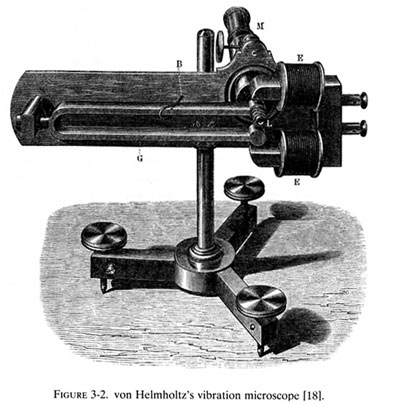
The effect of the interference of the two tones is complicated by the fact that the siren produces compound and not simple tones and that the interference of individual partial tones is independent of that of the prime tone and of one another. In order to damp the upper partial tones in the siren by means of a resonance chamber, I caused cylindrical boxes of brass to be made, of which the back halves are shewn [below]. These boxes are each made in two sections, so that they can be removed, and be again attached to the windchest by means of screws. When the tone of the siren approaches the prime tone of these boxes, its quality becomes full, strong and soft, like a fine tone on the French horn; otherwise the siren has rather a piercing tone. At the same time we use a small quantity of air, but considerable pressure. The circumstances are of the same nature as when a tongue is applied to a resonance chamber of the same pitch. Used in this way the siren is very well adapted for experiments on interference. (Helmholtz, 1877)
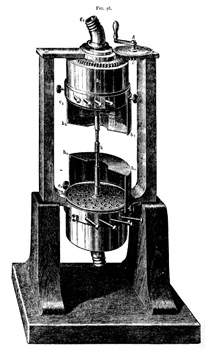
The threefold schema is intended to free the present moment from the power of the past by referring that power behind the absolute barrier of the unrepeatable and placing it at the disposal of the present as practical knowledge.The compulsion to rescue what is gone as what is living instead of using it as the material of progress was appeased only in art, to which history itself appertains as a presentation of past life. So long as art declines to pass as cognition and is thus separated from practice, social practice tolerates it as it tolerates pleasure. But the Sirens' song has not yet been rendered powerless by reduction to the condition of art... Even though the Sirens know all that has happened, they demand the future as the price of that knowledge, and the promise of the happy return is the deception with which the past ensnares the one who longs for it. (Adorno and Horkheimer, 1944)
What happens when an instrument creates beats with a sine wave? First, and most obviously, instruments produce more than one frequency. Second, when left alone, a sine wave oscillator produces a tone of unchanging frequency and amplitude (for all intents and purposes anyway). Instrumentalists cannot really match this stability. The effects of human irregularity are immediately obvious: any shift in pitch of the instrumental tone will change the frequency of beating between the instrument and the sine wave; any shift in amplitude of the instrumental tone will change the intensity of the beating (the constructive interference peaks will be smaller). Furthermore, you don't ever really get close to silence in the troughs of destructive interference as you do with two sinewaves, because the higher partials of the instrumental tone are still audible. The upper partials of the instrumental tone often seem to be amplitude modulated by the beats, but maintain a certain kind of independence.
 Excerpt from Alvin Lucier, In Memoriam Stuart Marshall, performance score
Excerpt from Alvin Lucier, In Memoriam Stuart Marshall, performance score  Lissajous figures from Helmholtz's vibration microscope
Lissajous figures from Helmholtz's vibration microscope
"...closely tune any number of oscillators, causing hyperbolas between the loudspeakers to spin in elliptical patterns through space at speeds determined by the tunings and in directions toward the lower-pitched loudspeakers." (Alvin Lucier, Still and Moving Lines of Silence in Families of Hyperbolas, 1974 version)
Spinning is a phenomenon that occurs when the sources of the two beating tones are physically independent, and is sometimes a little difficult to hear. It is caused by the gradual change of phase of the wavefronts relative to each other--only the first is registered perceptually because sounds that hit the ear in close succession mask each other. In this case imagine two loudspeaker, again emanating sinewaves, the right one tuned at 440 Hz and the left one at 441 Hz. The wavefronts are coming from the left speaker more frequently, so the first peak will arrive from that side just ahead of the peak from the right speaker. The discrepancy between the arrival times will gradually shift through the second it takes them to move out of, and then back into, phase, creating the impression of an elliptical movement through space from one speaker to the other. The movements at the beginning and end of the beat cycle (away from one speaker, and then back to the other) happen more rapidly than the shift in the middle of the cycle. In certain circumstances the impression of something moving behind your head can be quite vivid. Sometimes, sitting or standing closer to one source than the other seems to heighten the effect. I imagine this is because crosstalk between the two ears is minimizing the precedence effect if the listener is situated equidistant from the two loudspeakers.

Beats can also be heard when tones of slightly different frequency are presented separately to our two ears: these are called binaural beats. They are difficult to detect and are best heard with f-sub1 around 500 Hz and delta-f in the range of 5 to 20 Hz (Perrott and Nelson, 1969). They have been described as a "muffled" sound. When delta-f is less than 5 Hz, the beats change to a "rotating tone," a single tone that appears to move around inside the head. Binaural beats can be heard over a wide range of intensity of the stimulus tones; they apparently originate in the central auditory processor, not the individual ears. The rotating tone sensation is probably a result of the continuous change in phase, which makes it appear that the sound source is changing its direction. (Thomas D. Rossing, 1990)
What Odysseus hears is without consequence for him; he is able only to nod his head as a sign to be set free from his bonds; but it is too late; his men, who do not listen, know only the song's danger but nothing of its beauty, and leave him at the mast in order to save him and themselves... (The Sirens') temptation is neutralized and becomes an object of mere contemplation--becomes art. The prisoner is present at a concert, an inactive eavesdropper like later concertgoers, and his spirited call for liberation fades like applause. (Adorno and Horkheimer, 1944)
The mechanical siren, with its spinning disc, survives in the form of children's "siren whistles" or "ring whistles". Here the frequency sweep results from the acceleration of the disc's rotation upon being blown into.
In any event, the characteristic melos of the siren--its wailing, undulating glissando motion--results from the physical necessity of starting up the earliest sirens with a hand crank. Varèse's sirens are crank-driven. Later sirens retain this deeply evocative vocalise in spite of the removal of the manual contingency. The fire sirens still tested on Saturdays at five past noon in villages in Europe glide slowly up to a high-pitched steady tone and then descend to silence.
Perhaps unwittingly, the mechanical siren evokes its mythological ancestor on three counts. It sings a melody of an infinitely inclusive singular tone, not yet disembodied by stepwise division into named identities. It beckons with the wailing, yearning cadences of the spurned beasts. And it seduces with its announcement of danger and the nearness of death.
"...far enough west [on 14th Street] so that as he worked, all the river noises entered his room and he discovered the music in the foghorns... He listened to the 'parabolas and hyperbolas' of the fire-engine sirens with the haunting music, which he had, thanks to Helmholtz, discovered so long ago. Under the sirens' spell, he transposed their tracing to a number of glissandi within the score he was working on, to which he was to give the title Amériques: Americas, New Worlds." (Louise Varèse, 1972)
I began to resent the arbitrary limitations of the tempered system, especially after reading, at about the same time, Helmholtz's description of his experiments with sirens in his Physiology of Music. Wanting to experiment myself, I went to the Marché aux Puces, where for next to nothing you could find just about anything, and picked up two small ones. With these I made my first experiments in what I later called spatial music. The beautiful parabolas and hyperbolas of sound the sirens gave me and the haunting quality of the tones made me aware for the first time of the wealth of music outside the narrow limits imposed by keyboard instruments. (Edgard Varèse)

The phenomenon of the acoustical beat, measured by Helmholtz with the aid of the double siren, he calls in the original German Schwebung. "Beat" is a surprising translation (or an inexact apposition), expressing specifically the productive interference phase of the beat cycle, its loudest point, the crest or bump (Stoss) in the undulating period. Schweben in common use means to float in air, to hover, a weightless state. In calling the physical modulation of air molecules by closely tuned siren tones Schwebung, Helmholtz certainly intends to designate the complete cycle, from near-cancellation to amplitude peak and back, and possibly even the ongoing succession of individual cycles. But in experiencing beats, particularly very slow ones, it is the trough or near-null point which feels like floating. The disappearance of sound's substance approaches a feeling of being suspended.
Schweben is probably related to the English "sweeping" and "swooping", suggesting a continuous airborne motion that takes in all, possibly infinite, intermediate points. Thus Schwebung, the beat cycle, is in effect a circular sweep or glissando registered in amplitude or, when discernible, in aural space.
The immediate allure of the mythological Sirens is the purity of their tones. It is clear that they are two in number, and that their singing is intricately and beautifully intertwined. The declared reward of their song is a wisdom somehow related to a suspension of rigid, separate temporal identities.
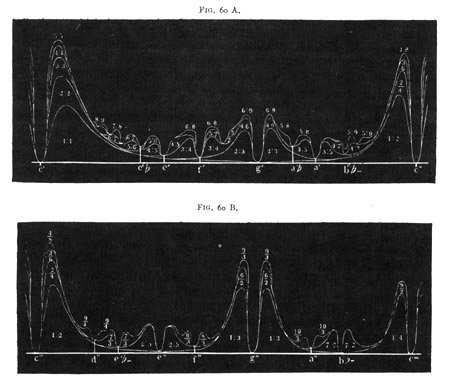 Graph of consonance of a sliding frequency against a stable reference (after Helmholtz)
Graph of consonance of a sliding frequency against a stable reference (after Helmholtz)
When I was a young boy I lived in New Hampshire and spent a lot of time outdoors. During the summer I went to a boys' camp. The owner of that camp, Arthur Evans, was a fascinating man, a kind of renaissance man: he was equally at home taking apart an automobile engine, reading philosophy, or studying the world of nature. Late in August, in the evening, as we left the dining room, he would suggest that we campers leave thirty seconds apart to walk back to our cabins a route we had never taken before, and be absolutely quiet and pay attention to the sounds of nature. We would go off alone at dusk and walk on a pathway, over a hill, through the forest, and you would hear evening birds and crickets and peepers and so forth. You would take a journey, and these things would open up to you. You didn't have to do anything but walk by. That was, for me, a very strong experience. (Alvin Lucier, 1982)
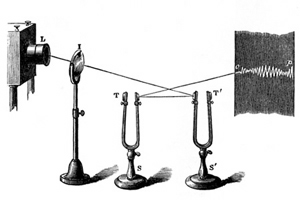 Visualization of Beats
Visualization of Beats
Bibliography:
- Theodor Adorno and Max Horkheimer, trans John Cumming, The Dialectic of Enlightenment, (New York: Continuum, 1998)
- Robert T. Beyer, Sounds of Our Times: Two Hundred Years of Acoustics (New York: Springer-Verlag, 1999)
- Steven Connor, Dumbstruck: A Cultural History of Ventriloquism, (Oxford: Oxford University Press, 2000)
- Hermann Helmholtz, trans and ed. Alexander J. Ellis, On the Sensations of Tone (New York: Dover, 1954)
- Homer, trans T.E. Shaw (pseudonym for T.E. Lawrence), The Odyssesy, (New York: Oxford University Press, 1932)
- Douglas Kahn, Noise, Water, Meat: A History of Sound in the Arts (Cambridge, Mass: MIT Press, 1999)
- Johannes Kepler, trans with introduction and notes by E.J Aiton, A.M. Duncan and J.V. Field, The Harmony of the World (Philadelphia: American Philosophical Society, 1997)
- Alvin Lucier with A. Margolin, "Conversation with Alvin Lucier" Perspectives in New Music Vol. 20 No. 1/2 (Summer 1982)
- Alvin Lucier, Reflections: Interviews, Scores, Writing (Koln: MusikTexte, 1995)
- Thomas D. Rossing, The Science of Sound, 2nd editon, (Reading, Mass: Addison-Wesley, 1990)
- John William Strutt, Baron Rayleigh, The Theory of Sound (New York: Dover, 1945)
- John Tyndall, Sound, 3rd edition (New York: Appleton and Company, 1898)
- Louise Varese, Varese: a Looking Glass Diary (New York: Norton, 1972)